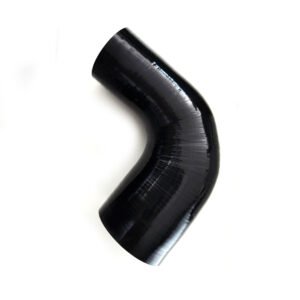A reducer silicone hose is a type of flexible hose made from silicone rubber that is designed to connect two pipes of different sizes. The hose is available in various sizes and configurations to meet specific application requirements.
Some of the key features and benefits of reducer silicone hoses include:
High temperature resistance: Reducer silicone hoses are designed to withstand high temperatures, making them suitable for use in high-temperature applications.
Chemical resistance: Reducer silicone hoses are resistant to a wide range of chemicals, including oils, fuels, and solvents.
Flexibility: Reducer silicone hoses are flexible, which allows them to be easily bent and shaped to fit the required application.
Durability: Reducer silicone hoses are durable and long-lasting, making them a reliable option for various applications.
Easy to install: Reducer silicone hoses are easy to install and can be used to connect pipes of different sizes and angles.
Aesthetically pleasing: Reducer silicone hoses are available in a range of colors and styles, which can improve the appearance of the installation.
Reducer silicone hoses are commonly used in automotive and industrial applications where pipes of different sizes need to be connected. It is important to select the appropriate reducer silicone hose based on the specific application and requirements, and to ensure that it is properly installed and maintained to ensure optimal performance and reliability.
Some of the major challenges associated with reducing silicon compounds include:
- High energy requirements: The reduction of silicon compounds like SiO2 to silicon requires very high temperatures, often above 1500°C. This consumes a lot of energy and can be costly.
- Byproduct handling: The reduction reactions produce oxide, gas or chloride byproducts that need to be properly handled and disposed of. For example, the Mg reduction of SiO2 produces silicon reducers supplier MgO that needs to be separated and collected. The gases like CO2 or HCl also need to be properly vented and scrubbed.
- Impurity removal: The raw silicon produced often contains impurities like boron, phosphorus, etc. that need to be removed for semiconductor grade silicon. Additional purification steps are required that increase cost and complexity.
- Safety: The high temperatures, reactive metals and gases involved pose potential safety hazards. Proper safety precautions need to be taken to avoid fires, explosions and release of toxic gases.
- Scaling challenges: It can be difficult to scale up some reduction processes to produce silicon on an industrial scale required for applications like solar cells, electronics, etc. Reactors need to be very large to achieve high volume production.
- Economics: Despite best efforts, the overall costs of reducing silicon compounds on an industrial scale can still be quite high due to the energy demands and capital equipment required. This can impact the economic viability of the process.
- Environmental impact: The high temperatures, use of reactive metals, and production of byproducts contribute to the overall environmental footprint of silicon reduction processes. Additional pollution control systems may be needed to minimize impact.
- Material handling: The raw and molten silicon as well as byproducts like MgO, CaO, etc. require specialized equipment and techniques for handling, transport and storage due to their reactive and hazardous nature. This also adds to the cost and complexity.
So in summary, high costs, safety issues, environmental impact, scaling challenges, and material handling are some of the major difficulties associated with reducing silicon compounds on an industrial scale. Ongoing research is focused on addressing these challenges to enable more efficient and economical production of elemental silicon.
